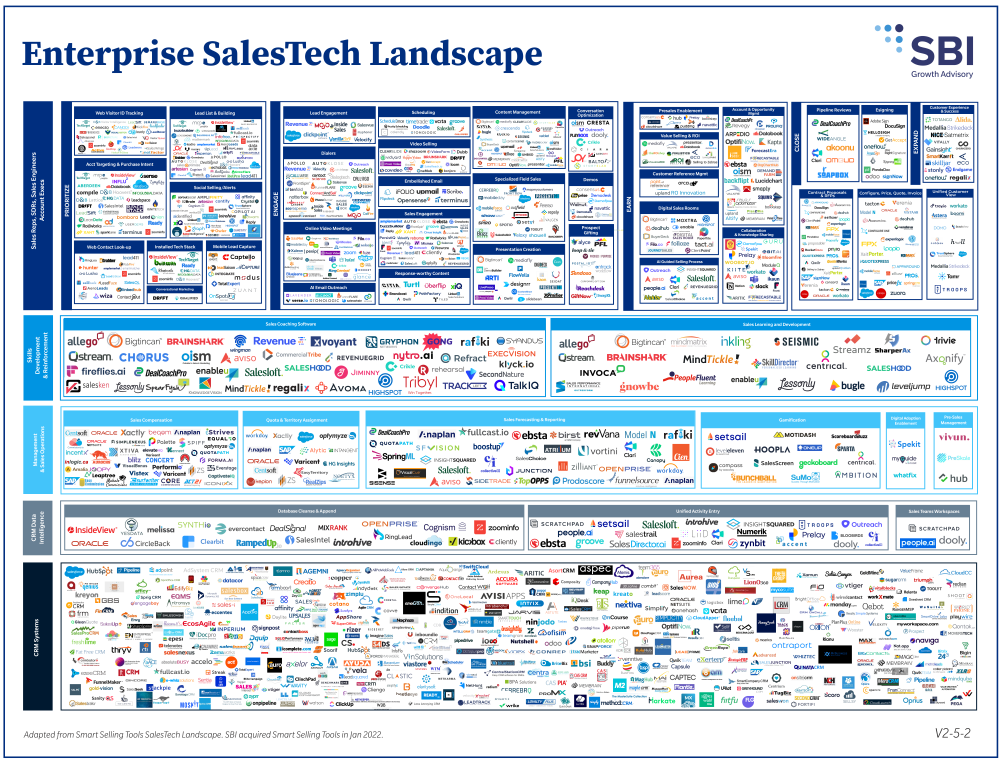In Part 1 of this two-part series, we presented research that draws conclusions between seller retention and a company’s SalesTech stack. We identified five main barriers that Sales Leaders face when selecting, implementing and optimizing SalesTech.
- Too Many Options
- Immature Purchasing and Implementation Processes
- Tools are Under-Utilized
- Tools Aren’t Fully Enabled
- Short-Term vs. Long-Term Focus
In this post, we share recommendations based on proper evaluation, processes, accountability and strategic thinking for sales leaders to work through the five main barriers, and maximize SalesTech investment and return.
Recommendation #1: Understand the Options
To understand your current state, you’ll need to identify which technology you have in use across your organization and which stage/s in the funnel they support. This will allow you to see potential gaps, consider their importance to your business, and then fill them by referring to the SalesTech Landscape.

Recommendation #2: Level Up Purchasing and Implementation Processes
Consider using the following framework—which we’ve labeled “EBAT”—to improve your org’s effectiveness at purchasing and installing new tools:
E: Who will be responsible for evaluating options, defining objectives, and determining the best fit? Appoint a standard buying team for commercial tech.
B: Who are the end users that will benefit from the solution, and how will we ensure that their needs align with the organization’s goals?
A: What administrative tasks are required for ongoing success? How will the tool integrate with other capabilities?
T: Who will oversee training and how will we measure its effectiveness over time?
Recommendation #3: Establish a Fact Base
Define what good looks like in terms of use, and then determine how you’ll monitor and measure outcomes. We recommend documenting the features and functionality of each solution you deploy, along with a roadmap for when you plan to roll features out (of course, you need not use every feature).
Recommendation #4: Enablement
Companies should appoint an employee (or a team) to oversee a tech roll-out roadmap that includes a plan for enablement, reinforcement, monitoring, and measuring success. Tech purchases should have clearly defined objectives, aligned metrics, and regular reporting, so that the organization can assess which tools are generating value and which are not. Be sure to include enablement of new sellers during their onboarding period.
Recommendation #5: Future-Back Thinking
The broader executive team should evaluate where and how technology can be deployed to accelerate the business’ growth or remove costs from the business.
After you achieve cross-functional alignment on the purpose, responsibilities, processes, and desired outcomes of your purchase, take steps to ensure that you’re not only on an even playing field with your competitors but are deploying innovative solutions that will put you ahead of the pack.
Conclusion
By reflecting on the following questions, you can dramatically improve your SalesTech stack:
- Do you have a clear view of your SalesTech across the organization?
- Is your process clearly defined for purchasing, implementing, and evaluating SalesTech, with assigned roles and responsibilities?
- Have you decided which features and functionality to deploy and when, and how to make it happen?
- Do you have a clear process for training and enabling users over time?
- What is your process for identifying capability gaps and closing them long-term?
For an analysis of your current state and benchmarks for comparison, contact us to talk about the SalesTech Stack Audit.

